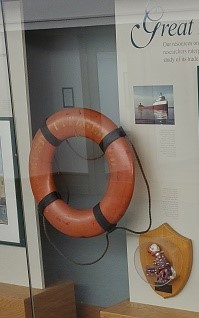
THE MAN WHO SANG THE SONG THAT MADE THE SHIP IMMORTAL HAS DIED
By James Heinz
Most Great Lakes shipwrecks die anonymous deaths, their loss remembered only by marine history buffs like myself. This is true of most shipwrecks. About the only shipwreck most people can remember is the TITANIC, and that is more because of the life stories of her thousands of passengers. Cargo ships in particular are forgotten by everyone except the families of those lost on the ship.
But one man made one shipwreck immortal through a song.
The most famous shipwreck in the history of the Great Lakes, and, to most Americans, the second most famous shipwreck after the TITANIC, is the SS EDMUND FITZGERALD. And she is remembered because the Canadian folk singer Gordon Lightfoot made her immortal through his song “The Wreck of the Edmund Fitzgerald.”
And now, like the ship whose loss he chronicled, Gordon Lightfoot has broke deep and took water, and all that remains are the faces and the names of the wives and the sons and the daughters he left behind.
(He had three wives, three sons, three daughters, and many girlfriends. One of his ex-girlfriends was the woman who injected John Belushi with a fatal dose of heroin.)
Gordon Meredith Lightfoot was born November 17, 1938 in Orillia, Ontario. He died May 1, 2023 in Toronto, Ontario of what was described as natural causes. In between he lived a lot of life. Influenced by the folk music scene of the late 1950s and early 1960s, he released 20 albums and received sixteen Juno awards, Canada’s version of the Grammy Awards.
Many of his albums went gold and multi platinum. He was considered Canada’s greatest song writer and wrote most of the songs on his albums. Bob Dylan said that he never met a Gordon Lightfoot song he did not like, and considered Lightfoot a mentor.
But the song he will probably be best remembered for is “The Wreck of the Edmund Fitzgerald”. And there are two different stories about what inspired him to write it.
Wikipedia says that Lightfoot read a November 24, 1975, Newsweek magazine article about the loss of the EDMUND FITZGERALD, which had occurred two weeks earlier, on November 10, 1975. That is how important the national media thought the story was at the time. They waited 2 full weeks to report on it in detail.
The New York Times says “The morning after the Fitzgerald went down, the rector of Mariners’ Church of Detroit tolled its bell 29 times, once for each man lost. An Associated Press reporter knocked on the church’s door, interviewed the rector and filed an account that was published in newspapers. Mr. Lightfoot read the article.”
Lightfoot read either or both stories and was inspired to write the song because he did not want the ship to be forgotten. And he succeeded beyond his wildest dreams. The song, released on his 1976 album “Summertime Dream”, sprang to number one on the Canadian song charts, and to number two on the U.S. music charts, and spent 21 weeks on the Billboard music charts.
Lightfoot considered it his finest work, and he was right.
What was amazing about the song’s popularity is that it is completely different from almost every other popular song. Most popular songs are about love and romance, and the worst thing that happens is that someone gets their heart broken.
But The Wreck of the Edmund Fitzgerald is a dirge, a depressing story about a doomed ship and her 29 equally doomed crewmen. You can’t dance to it, and as the New York Times described it, “It famously defied Top 40 logic”. Not only is it a dirge, but it is 6.5 minutes long, much longer than the average pop single.
In addition, most pop songs are completely made up, or based loosely on a real person or incident. John Lennon wrote “Rita, Lovely Meter Maid” after an encounter with a London parking checker, but that is about as close to actual persons or events as most pop songs get. No artist will let an ugly fact ruin a beautiful story.
But “The Wreck of the Edmund Fitzgerald” has been described as “a documentarian’s song.” Although a couple of minor facts have been changed, Lightfoot tried to stick meticulously to the facts. He said that he agonized over the few changes to the facts that he made in the song. And when subsequent investigations of the wreck provided additional evidence of how the ship sank, he changed the lyrics slightly to reflect the new information.
Perhaps the most haunting lyric is when the old cook came on deck and said “Fellas, it been good to know you.” Whether Lightfoot knew it or not, another man who did not survive another famous Great Lakes shipwreck said the same thing.
According to Wikipedia: “Norm Bragg, who survived this wreck (of the HENRY STEINBRENNER II in 1953) in Lake Superior, was a watchman on board the SS DANIEL J. MORRELL, when it sank in Lake Huron. He helped his crew understand their plight, gave quick advice and said, “It’s been good to know you.”
Lightfoot also kept in touch with the families of the crew members, and treasured newspaper clippings and items given to him by the families, and appeared at several 25th anniversary ceremonies.
If after you finish listening to the song you feel depressed, you may want to cheer yourself up with the two parodies of the song by the political satire group “The Capitol Steps” entitled “The Wreck of the Walter ‘Fritz’ Mondale” and “The Wreck of the Hilary Clinton”, written after those two unsuccessful presidential campaigns sank in a manner not dissimilar to the ship itself.
The only person I ever met who didn’t like the song was my father. When it was at the height of its popularity, the radio station my father had set his clock radio alarm to always played the song at the same time as the clock radio came on and woke up my father. He hated being woken from a sound sleep on a cold dark winter morning by a tale of men dying on a cold dark night. It was a depressing way to start his day.
Perhaps the only bad effects of the song is that it inspired a cottage industry of speculation on why the ship sank that has turned the Big Fitz’s sinking into something like the Kennedy Assassination of the Great Lakes. (If you watch the Zapruder Film closely, you can see Captain McSorley on the grassy knoll in Dallas. He’s the guy standing between Elvis and the Roswell aliens.)
One book even claimed that the reason no bodies were recovered was not because Superior it is said never gives up its dead, but because the crew had been abducted by aliens in a UFO. I swear to you that I am not making this up.
Lightfoot had overcome many health problems over the years, including Bell ’s palsy, a near fatal abdominal aneurism, and having a stroke on stage while performing. Like Paul McCartney, a rumor that he had died once suddenly began spreading on Twitter and Facebook while he was at the dentist. This time however, reports of his death have not been greatly exaggerated.
WMHS Soundings editor Kathy Gordon brought to my attention a memorial to Lightfoot that he surely would have appreciated. Since 1985 the Split Rock Lighthouse has been illuminating its light and tolling its bell 29 times every November 10 to commemorate the sinking. This began when the lighthouse’s site manager heard the song on his car radio on November 10, 1985. On May 3, 2023, two days after Lightfoot’s death, Split Rock illuminated its light from 9 pm to 11 pm in honor of him.
Perhaps the most fitting memorial to Lightfoot is posted on the Wikipedia entry for the Mariner’s Church of Detroit, the “maritime sailor’s cathedral” in the song: “On May 2, 2023, the day after Gordon Lightfoot’s death, the church’s bell tolled 30 times, once for each of the Edmund Fitzgerald’s 29 crew members and once in memory of Gordon Lightfoot.”
I am sure Gordon would have been pleased to know he was remembered in a musty old hall in Detroit.
The lyrics of the legendary song are listed below. All I can say to the lost legend maker who wrote it is, “Fella, it’s been good to know ya.”
The legend lives on from the Chippewa on down
Of the big lake they called Gitche Gumee
The lake, it is said, never gives up her dead
When the skies of November turn gloomy
With a load of iron ore twenty-six thousand tons more
Than the Edmund Fitzgerald weighed empty
That good ship and true was a bone to be chewed
When the gales of November came early
The ship was the pride of the American side
Coming back from some mill in Wisconsin
As the big freighters go, it was bigger than most
With a crew and good captain well seasoned
Concluding some terms with a couple of steel firms
When they left fully loaded for Cleveland
And later that night when the ship’s bell rang
Could it be the north wind they’d been feelin’?
The wind in the wires made a tattle-tale sound
And a wave broke over the railing
And every man knew, as the captain did too
T’was the witch of November come stealin’
The dawn came late and the breakfast had to wait
When the gales of November came slashin’
When afternoon came it was freezin’ rain
In the face of a hurricane west wind
When suppertime came, the old cook came on deck sayin’
“Fellas, it’s too rough to feed ya”
At seven PM, a main hatchway caved in, he said
“Fellas, it’s been good to know ya”
The captain wired in he had water comin’ in
And the good ship and crew was in peril
And later that night when his lights went outta sight
Came the wreck of the Edmund Fitzgerald
Does any one know where the love of God goes
When the waves turn the minutes to hours?
The searchers all say they’d have made Whitefish Bay
If they’d put fifteen more miles behind her
They might have split up or they might have capsized
They may have broke deep and took water
And all that remains is the faces and the names
Of the wives and the sons and the daughters
Lake Huron rolls, Superior sings
In the rooms of her ice-water mansion
Old Michigan steams like a young man’s dreams
The islands and bays are for sportsmen
And farther below Lake Ontario
Takes in what Lake Erie can send her
And the iron boats go as the mariners all know
With the gales of November remembered
In a musty old hall in Detroit they prayed
In the maritime sailors’ cathedral
The church bell chimed ’til it rang twenty-nine times
For each man on the Edmund Fitzgerald
The legend lives on from the Chippewa on down
Of the big lake they called Gitche Gumee
Superior, they said, never gives up her dead
When the gales of November come early.
Photo is of the life ring and christening bottle from the EDMUND FITZGERALD located on the second floor of Milwaukee’s Central Library, 814 W. Wisconsin Avenue.
____________________________________
James Heinz is the Wisconsin Marine Historical Society’s acquisitions director. He became interested in maritime history as a kid watching Jacques Cousteau’s adventures on TV. He was a Great Lakes wreck diver until three episodes of the bends forced him to retire from diving. He was a University of Wisconsin – Milwaukee police officer for thirty years. He regularly flies either a Cessna 152 or 172.
